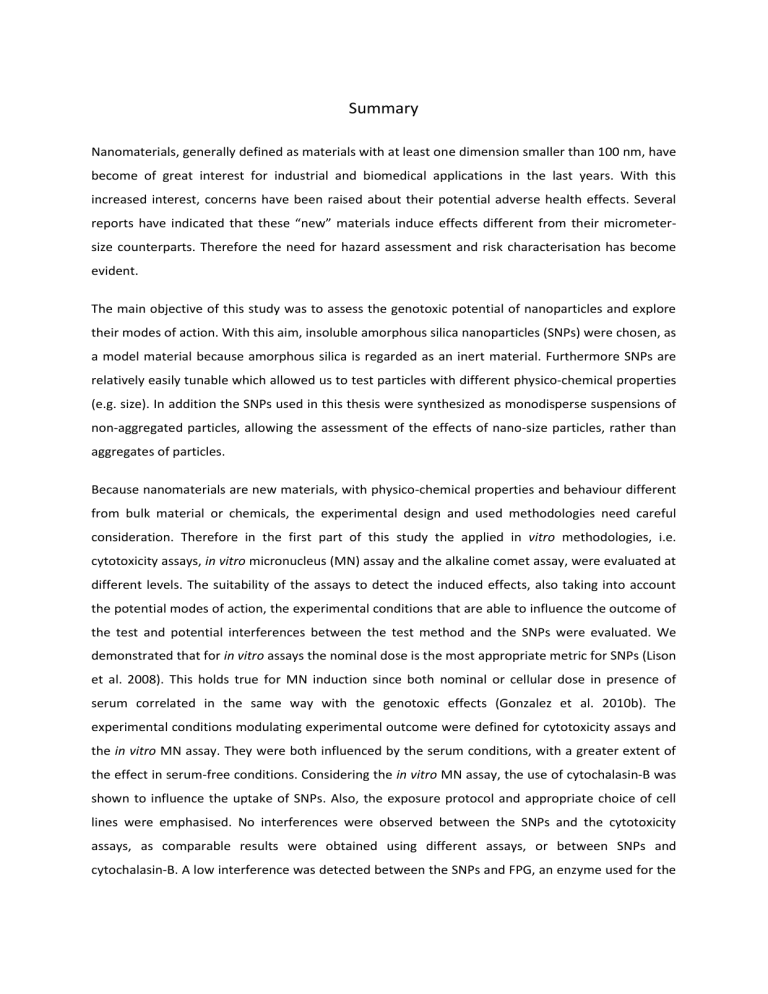
Summary
Nanomaterials, generally defined as materials with at least one dimension smaller than 100 nm, have
become of great interest for industrial and biomedical applications in the last years. With this
increased interest, concerns have been raised about their potential adverse health effects. Several
reports have indicated that these “new” materials induce effects different from their micrometersize counterparts. Therefore the need for hazard assessment and risk characterisation has become
evident.
The main objective of this study was to assess the genotoxic potential of nanoparticles and explore
their modes of action. With this aim, insoluble amorphous silica nanoparticles (SNPs) were chosen, as
a model material because amorphous silica is regarded as an inert material. Furthermore SNPs are
relatively easily tunable which allowed us to test particles with different physico-chemical properties
(e.g. size). In addition the SNPs used in this thesis were synthesized as monodisperse suspensions of
non-aggregated particles, allowing the assessment of the effects of nano-size particles, rather than
aggregates of particles.
Because nanomaterials are new materials, with physico-chemical properties and behaviour different
from bulk material or chemicals, the experimental design and used methodologies need careful
consideration. Therefore in the first part of this study the applied in vitro methodologies, i.e.
cytotoxicity assays, in vitro micronucleus (MN) assay and the alkaline comet assay, were evaluated at
different levels. The suitability of the assays to detect the induced effects, also taking into account
the potential modes of action, the experimental conditions that are able to influence the outcome of
the test and potential interferences between the test method and the SNPs were evaluated. We
demonstrated that for in vitro assays the nominal dose is the most appropriate metric for SNPs (Lison
et al. 2008). This holds true for MN induction since both nominal or cellular dose in presence of
serum correlated in the same way with the genotoxic effects (Gonzalez et al. 2010b). The
experimental conditions modulating experimental outcome were defined for cytotoxicity assays and
the in vitro MN assay. They were both influenced by the serum conditions, with a greater extent of
the effect in serum-free conditions. Considering the in vitro MN assay, the use of cytochalasin-B was
shown to influence the uptake of SNPs. Also, the exposure protocol and appropriate choice of cell
lines were emphasised. No interferences were observed between the SNPs and the cytotoxicity
assays, as comparable results were obtained using different assays, or between SNPs and
cytochalasin-B. A low interference was detected between the SNPs and FPG, an enzyme used for the
detection of oxidised purines when combined with the alkaline comet assay. Overall, the assays were
esteemed suitable for assessing the cellular responses of SNPs.
Applying the in vitro MN assay (cytokinesis-block MN and flow cytometry based MN assay) the
genotoxic potential was assessed of SNPs ranging from 12 to 174 nm. For most SNPs an induction of
MN was observed, except for S-28 and S-139 in the absence of serum. No biologically significant
induction of MN was observed for any of the SNPs tested, either in presence or absence of serum.
MN induction by SNPs did not show a clear dose-dependent or size-dependent relationship when
considering mass dose. Several dose-effect curves for nanoparticles show a plateau for a given range
of doses, which might reflect dynamic steady state cellular dose as a consequence of
endocytosis/exocytosis or saturation of uptake. However, we showed that, when expressing MN data
for the 16, 60 and 104 nm SNPs together, a statistically significant correlation was observed between
the fold MN induction and total surface area dose and the dose expressed as particle number,
indicating that these metrics determine the in vitro induction of MN in presence of serum (Gonzalez
et al. 2010b). Therefore the use of appropriate dose metrics is of great importance for the
interpretation of results.
Potential modes of action, i.e. the generation of reactive oxygen species and mechanical interference
of cellular components were explored, after treatment of A549 cells with 16, 60 and 104 nm SNPs in
presence of serum. Results showed weak and not statistically significant induction of DNA strand
breaks and oxidized purines. Furthermore, chromosome loss, mitotic arrest and mitotic slippage
were induced by SNPs, although not statistically significantly, indicative of spindle interference
(Gonzalez et al. 2010b).
The hypothesis of spindle interference was further investigated in situ and in absence of serum. No
clear interference of the mitotic spindle or preferential distribution of the fluorescently labeled SNPs
was observed. Furthermore no induction of multi-polar spindles was recorded. The main finding was
that treatment of A549 cells with S-28, S-59 and S-174 induced a promotion of microtubule
repolymerisation after cold treatment (Gonzalez et al. 2011 d) and this at doses where no cell toxicity
was observed. This in situ promotion of microtubule repolymerisation was not associated with
increased acetylation.
In conclusion, the cytotoxic and genotoxic potential of SNPs was assessed after evaluation of the
applied tests for their suitability, the experimental conditions influencing their outcome and possible
interferences with SNPs. Both cytotoxic and genotoxic effects were induced by SNPs. The mode of
action of SNPs responsible for the observed weak genotoxic effects were investigated and revealed
non-statistically significant increases of oxidised purines, chromosome loss, mitotic arrest and mitotic
slippage. The latter three point to spindle interference. Examination of the effects of SNPs on
microtubules showed an in situ promotion of microtubule repolymerisation.
Samenvatting
Nanomaterialen, gedefinieerd als materialen met ten minste één dimensie kleiner dan 100 nm,
worden in de laatste jaren met toenemende interesse onderzocht voor biomedische en industriële
toepassingen. Deze toenemende interesse gaat gepaard met toenemende bezorgdheid aangaande
hun potentiële nadelige effecten. Verschillende rapporten hebben aangetoond dat deze “nieuwe”
materialen effecten induceren die verschillen van deze geïnduceerd door micrometer-partikels met
dezelfde chemische samenstelling. Daarom is hazard bepaling en risico karakterisatie noodzakelijk.
Het doel van deze studie was het bepalen van het genotoxicsch potentieel van nanopartikels en hun
‘modes of action’ te onderzoeken. Onoplosbare amorfe silica nanopartikels (SNPs) werden gekozen,
als model materiaal omdat amorfe silica partikels als biologisch inert beschouwd worden.
Daarenboven zijn ze relatief gemakkelijk te moduleren wat het mogelijk maakt om partikels met
verschillen fysico-chemische eigenschappen (bvb. grootte) te testen. De SNPs gebruikt in deze studie
werden gesynthetiseerd als monodisperse suspensies van niet-geaggregeerde partikels. Hiermee was
het mogelijk de effecten van nano-dimensie van de partikels, en niet aggregaten van nanopartikels te
onderzoeken.
Omdat nanomaterialen nieuwe materialen zijn, met fysico-chemische eigenschappen en gedrag
verschillend van bulk materialen en chemicaliën, dienen de experimentele design en de aangewende
methodologieën overwogen te worden. Daarom werden, in het eerste deel van deze studie, de
gebruikte methodologieën, namelijk celtoxiciteits assays, de in vitro micronucleus (MN assay) en de
comet assay geëvalueerd op verschillende niveaus. De geschiktheid van de assays om de
geïnduceerde effecten te detecteren, waarbij ook potentiële ‘modes of action’ werden in acht
genomen, de experimentele condities die de resultaten van de tests beïnvloeden en de potentiële
interferenties tussen de test methodes en de SNPs werden geëvalueerd. We hebben aangetoond dat
voor in vitro assays de nominale dosis de meest geschikte metriek is (Lison et al. 2008). Dit werd ook
bevestigd door de gelijkaardige correlatie tussen de inductie van MN en de nominale of cellulaire
dosis, aangetoond in aanwezigheid van serum (Gonzalez et al. 2010b). De experimentele condities
die de resultaten van de cytotoxiciteits assays en de in vitro MN assay beïnvloeden, werden
gedefinieerd. Beide assays werden beïnvloed door serum condities, met grotere effecten
waargenomen in serum-vrije condities. Betreffend de in vitro MN assay werd aangetoond dat het
gebruik van cytochalasin-B de SNP opname beïnvloedt. Ook de blootstellingstijd en de geschikte
celkeuze werd benadrukt. Er werden geen interferenties gevonden tussen de SNPs en de
cytotoxiciteits assays, aangezien gelijkaardige resultaten werden bekomen wanneer verschillende
tests werden toegepast. Een lage interferentie werd waargenomen tussen SNPs en en FPG, een
enzyme dat wordt gebruikt voor de detectie van geoxideerde purines wanneer gecombineerd met de
alkaline comet assay.
Aan de hand van de in vitro MN assay (cytokinesis-block MN en flow cytometry based MN assay)
werd het genotoxisch potentieel van SNPs (12-174 nm) bepaald. Voor het merendeel van de SNPs
werd de inductie van MN geobserveerd, behalve voor S-28 en S-139 in de afwezigheid van serum.
Voor geen enkel SNP werd er een biologisch significante inductie van MN geobserveerd, in aan- of
afwezigheid van serum.
MN inductie vertoonde geen duidelijk dosis-afhankelijke of grootte-afhankelijke relatie wanneer de
massa dosis werd beschouwd. Verschillende dosis-effect curves vertonen een plateau-fase voor
bepaalde dose-ranges, hetgeen zou kunnen wijzen op een dynamische steady-state cellulaire dosis
als gevolg van endocytose/exocytose of saturatie van de opname. Wij hebben aangetoond dat bij
combinatie van de data voor de drie partikels tesamen (16, 60 en 104 nm) een statistisch significante
correlatie wordt gevonden tussen de inductie van MN en de dosis uitgedrukt in oppervlakte en
partikelaantal. Dit wijst erop dat deze maat de in vitro inductie van MN determineren in
aanwezigheid van serum (Gonzalez et al. 2010b). Daarenboven wijst dit op het belang van het
gebruik van geschikte dosis maten voor de interpretatie van resultaten.
Potentiële ‘modes of action’, namelijk de productie van reactieve zuurstofsoorten en mechanische
interferentie met cellulaire componenten, werden onderzocht, na behandeling van A549 cellen met
16, 60 en 104 nm SNPs in aanwezigheid van serum. Resultaten toonden een zwakke, niet statistisch
significante inductie van DNA breuken en geoxideerde purines. Daarenboven werden
chromosoomverlies, mitotische block en mitotische ‘slippage’ geïnduceerd, hoewel niet statistisch
significant, hetgeen indicatief is voor interferentie met de spoelfiguur.
De hypothese van interferentie met de spoelfiguur werd verder in situ onderzocht in de afwezigheid
van serum. Er werd geen duidelijk interferentie van de spoelfiguur of preferentiële distributie van
fluorescent-gelabelde SNPs geobserveerd. Daarenboven werd er geen inductie van multi-polaire
spoelfiguren genoteerd. Behandeling van A549 cellen met S-28, S-59 en S-174 induceerde een
promotie van de microtubule-repolymerisatie na koude-behandeling (Gonzalez et al. 2011d) en dit
bij doses die geen cytotoxiciteit induceerden. Deze in situ promotie van repolymerisatie was niet
geassocieerd met verhoogde microtubule acetylatie.
In conclusie, het cytotoxisch en genotoxisch potentieel van SNPs werd onderzocht na evaluatie van
de toegepaste assays. Deze werden geëvalueerd voor hun geschiktheid, de experimentele condities
die het resultaat kunnen beinvloeden en potentiële interferenties met SNPs. SNPs induceerden
cytotoxische en genotoxische effecten. De ‘modes of action’ van de SNPs, verantwoordelijk voor de
geobserveerde zwakke genotoxische effecten, werden onderzocht. Dit toonde aan dat nietstatistisch significante stijgingen van geoxideerde purines, chromosoomverlies, mitotische block en
‘mitotic slippage‘ werden geïnduceerd. Deze laatste drie zijn indicatief voor interferentie met de
spoelfiguur. Onderzoek naar de effecten van SNPs op microtubuli toonde een in situ promotie van
microtubuli repolymerisatie aan.












